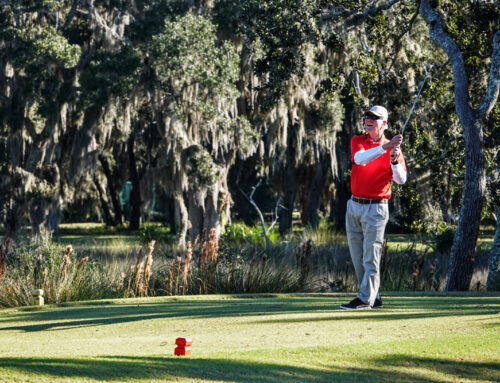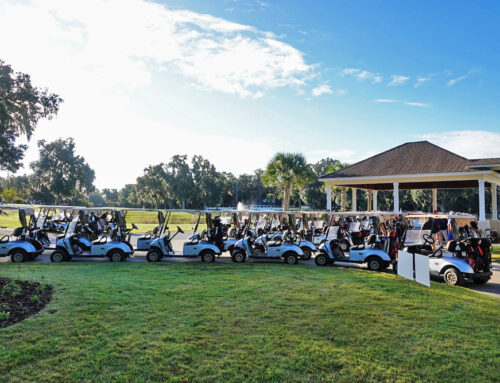 Coastal golf in Georgia is largely associated with either the Brunswick/Golden Isles area or Savannah. But there is one largely undiscovered gem located midway between the two that is experiencing a welcome comeback.
Coastal golf in Georgia is largely associated with either the Brunswick/Golden Isles area or Savannah. But there is one largely undiscovered gem located midway between the two that is experiencing a welcome comeback.
Sapelo Hammock opened in 1999 in the coastal community of Shelman Bluff, just outside Darien. The course received initially positive reviews, but the early focus was more on the surrounding development than the golf course, and in the Fall of 2010, the course closed for play.
A sizeable group of individuals who own property in the area purchased the club, which reopened last Summer after being out of commission for almost a year. The effort to restore the course to quality conditions was sufficiently successful that there is no evidence that Sapelo Hammock was out of play a little over a year ago.
With the course again in excellent shape, Sapelo Hammock is back on the path to becoming a major player in the coastal golf scene, offering one of the most visually appealing and enjoyable courses in the state.
The club is now managed by CGL of Savannah, which has been recognized for its work with Arrowhead Pointe, one of the Georgia State Parks newer and most successful courses, as well as Mystery Valley and Collins Hill in metro Atlanta and Henderson Golf Club in Savannah.
Alan Cale, CGL’s Vice President, says the club is looking to both add to its membership and increase its daily fee business, with the long term goal of making Sapelo Hammock a “stay and play destination.” The club is also looking to attract more outings and tournaments, and is close enough to both Savannah and the Brunswick area to be able to generate business.
Those who recognized the early promise of Sapelo Hammock but heard about its recent struggles and closing will be heartened by the work to restore the hope of a bright future for the club.
In addition to the improvements to course conditions, the overall facility has also been upgraded. The dining facility is first rate, with the club also featuring a nicely appointed guest room above the clubhouse that can accommodate four with ample amounts of space and a wonderful view of the marshes bordering the course.
Both nines conclude with holes that play along or over the marshes and offer memorable conclusions to each side. The visual appeal of the course is strong from the outset, with live oaks, overhanging moss and a variety of hazards making for some pleasant views, while providing most of Sapelo Hammock’s considerable challenge.
Sapelo Hammock was designed by Rusty Simmons, who worked with Davis Love’s design firm. It was his first solo effort and has been well-regarded since it opened. The new owners made virtually no changes to Simmons’ excellent layout while restoring it other than making a few of the more hazardous holes play a bit shorter with some minor tee adjustments.
The course measures a modest 6,866 yards from the back tees, although there are a few holes, most notably the par-5 ninth, that can be very daunting for all but the best players if they try to play it all the way back.
Among Sapelo Hammock’s strengths is the spacing between tees, with the blues a very playable 6,373 and the whites a comfortable 5,908. The course is rated at 72.9/134 from the tips, 70.4/126 from the blues and 68.4/122 from the whites, with the slope rating from the blues and whites likely a bit on the low side considering the amount of trouble in play.
The gold tees measure 5,344 yards, with the reds right at 4,900.
For the most part, Sapelo Hammock is relatively generous off the tee. However, the live oaks and pines are frequently a serious concern, although they are also capable of re-directing errant shots back into play. While there are a decent number of water hazards, the bunkering is minimal and the greens complexes, with an exception or two, are on the gentle side. The excellent Bermuda putting surfaces are mostly average to small in size, with sufficient subtlety to perplex those more accustomed to bent grass greens.
The opening stretch of holes is reasonably tame apart from a pair of mid-length par 4s, one with water one without. The third features a lagoon that runs all the way down the right side to the green, with the approach offering bailout room to the left. The green includes a back right bowl that makes for some interesting approaches and short game shots with the lagoon not far off.
The seventh presents a slightly deceptive look from the tee, with a trio of bunkers down the left seemingly swallowing up the entire landing area. There is plenty of room right of them, with bigger hitters having the option of trying to carry the bunkers, but at some risk.
A pair of short-ish par 4s and a modest par-5 with a large grass bunker off the tee and a significantly sloping green provide some potential scoring opportunities before you are introduced to both the beauty and sometimes beastly nature of marsh-side golf.
The eighth hole is an all-carry par 3 over the marsh, with the black, blue and white tees all about 20 yards shorter than they were initially, but still a serious challenge from each set.
There is room to miss long beyond the shallow green, but anything short or right is in the marsh, with tall reeds obscuring the view of the putting surface and adding to the intimidating nature of the tee shot. One of the state’s most appealing, but also most demanding, par 3s.
The ninth requires a carry in the 240-yard range to clear the marsh and reach the fairway from the tips. The marsh is also very much in play down the right side and live oak trees with overhanging moss loom to the left. Lay-up shots also have to navigate the marsh right and a tree left to set up a delicate third shot to a small target.
Like the front nine, the early holes on the back are relatively inviting, although the par-5 12th has its challenges, beginning with a tee shot that has to be precise to avoid clumps of pesky trees right and left than can require some inventive second shots. If you can avoid trouble right on the lay-up, the short third shot offers minimal resistance.
Sapelo Hammock’s hazardous stretch of finishing holes begins at the 16th, a mid-length par 4 with a pond and bulkhead wall zealously guarding right side pin positions. The fairway is generous and there is room left of the water, but any shot that challenges a right side hole location had better be well struck, no matter the yardage.
Like the eighth, the 17th is all carry over the marsh, with its appearance changing dramatically depending on the tide. The marsh surrounds the large, rolling green with a little room to miss around the edges. Just having a birdie putt is no guarantee of a par, with the size and slope of the putting surface making it among the most challenging on the course.
The 18th was originally a short but perilous par 5 and now is a little shorter and easily within reach in two for most low and mid-handicap players. There is plenty of trouble along the way, however, beginning with live oaks just in front of the tee to the right. The marsh hugs the left side and is very much in play on the lay-up for shorter hitters, creeping in along the right and crossing the fairway well short of the green, with trees blocking access from the left.
It’s an inviting but potentially frustrating finishing hole that caps a thoroughly enjoyable and memorable day on a course that should be on the must play list for anyone making a golf trip to Savannah or the Jekyll/St. Simons area.
Both Savannah and Brunswick are less than an hour away, and the course is not much more than 10 minutes off I-95 from both the north and south. The extremely affordable rates are also a draw for golfers from outside the immediate area, and there are very few (if any) courses in the state that provide as enjoyable an overall golf experience as you’ll get at Sapelo Hammock.




